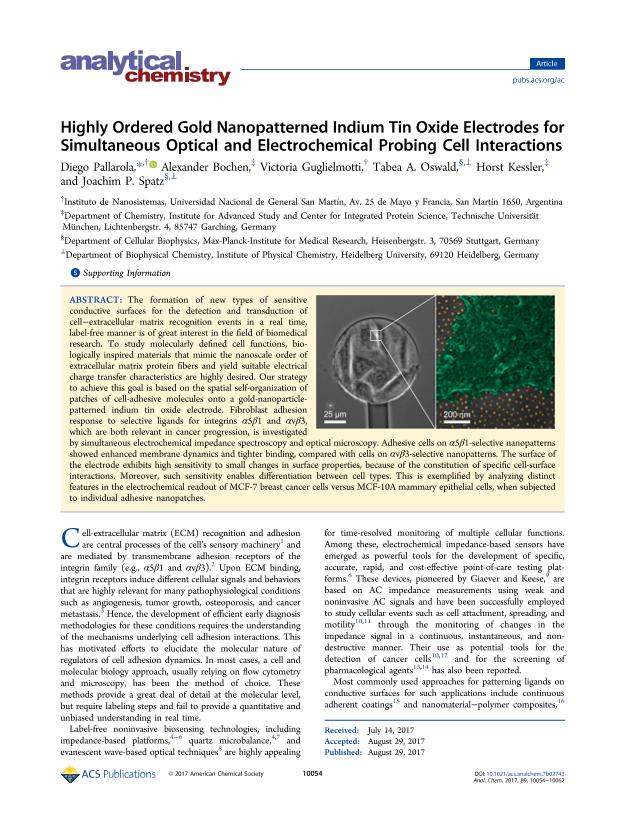Mostrar el registro sencillo del ítem
dc.contributor.author
Pallarola, Diego Andres

dc.contributor.author
Bochen, Alexander
dc.contributor.author
Guglielmotti, Victoria

dc.contributor.author
Oswald, Tabea A.
dc.contributor.author
Kessler, Horst
dc.contributor.author
Spatz, Joachim P.
dc.date.available
2018-04-06T17:21:49Z
dc.date.issued
2017-09
dc.identifier.citation
Pallarola, Diego Andres; Bochen, Alexander; Guglielmotti, Victoria; Oswald, Tabea A.; Kessler, Horst; et al.; Highly Ordered Gold Nanopatterned Indium Tin Oxide Electrodes for Simultaneous Optical and Electrochemical Probing Cell Interactions; American Chemical Society; Analytical Chemistry; 89; 18; 9-2017; 10054-10062
dc.identifier.issn
0003-2700
dc.identifier.uri
http://hdl.handle.net/11336/41153
dc.description.abstract
The formation of new types of sensitive conductive surfaces for the detection and transduction of cell–extracellular matrix recognition events in a real time, label-free manner is of great interest in the field of biomedical research. To study molecularly defined cell functions, biologically inspired materials that mimic the nanoscale order of extracellular matrix protein fibers and yield suitable electrical charge transfer characteristics are highly desired. Our strategy to achieve this goal is based on the spatial self-organization of patches of cell-adhesive molecules onto a gold-nanoparticle-patterned indium tin oxide electrode. Fibroblast adhesion response to selective ligands for integrins α5β1 and αvβ3, which are both relevant in cancer progression, is investigated by simultaneous electrochemical impedance spectroscopy and optical microscopy. Adhesive cells on α5β1-selective nanopatterns showed enhanced membrane dynamics and tighter binding, compared with cells on αvβ3-selective nanopatterns. The surface of the electrode exhibits high sensitivity to small changes in surface properties, because of the constitution of specific cell-surface interactions. Moreover, such sensitivity enables differentiation between cell types. This is exemplified by analyzing distinct features in the electrochemical readout of MCF-7 breast cancer cells versus MCF-10A mammary epithelial cells, when subjected to individual adhesive nanopatches.
dc.format
application/pdf
dc.language.iso
eng
dc.publisher
American Chemical Society

dc.rights
info:eu-repo/semantics/openAccess
dc.rights.uri
https://creativecommons.org/licenses/by-nc-sa/2.5/ar/
dc.subject
Electrochemical Impedance Sensor
dc.subject
Cell Adhesion
dc.subject
Integrins
dc.subject
Gold Nanopatterns
dc.subject
Transparent Microelectrodes
dc.subject.classification
Otras Ciencias Químicas

dc.subject.classification
Ciencias Químicas

dc.subject.classification
CIENCIAS NATURALES Y EXACTAS

dc.subject.classification
Otras Biotecnologías de la Salud

dc.subject.classification
Biotecnología de la Salud

dc.subject.classification
CIENCIAS MÉDICAS Y DE LA SALUD

dc.title
Highly Ordered Gold Nanopatterned Indium Tin Oxide Electrodes for Simultaneous Optical and Electrochemical Probing Cell Interactions
dc.type
info:eu-repo/semantics/article
dc.type
info:ar-repo/semantics/artículo
dc.type
info:eu-repo/semantics/publishedVersion
dc.date.updated
2018-04-06T13:44:52Z
dc.journal.volume
89
dc.journal.number
18
dc.journal.pagination
10054-10062
dc.journal.pais
Estados Unidos

dc.description.fil
Fil: Pallarola, Diego Andres. Universidad Nacional de San Martin. Instituto de Nanosistemas; Argentina. Consejo Nacional de Investigaciones Científicas y Técnicas; Argentina
dc.description.fil
Fil: Bochen, Alexander. Technische Universitat Munchen; Alemania
dc.description.fil
Fil: Guglielmotti, Victoria. Universidad Nacional de San Martin. Instituto de Nanosistemas; Argentina
dc.description.fil
Fil: Oswald, Tabea A.. Max Planck Institute for Medical Research; Alemania. Heidelberg University; Alemania
dc.description.fil
Fil: Kessler, Horst. Technische Universitat Munchen; Alemania
dc.description.fil
Fil: Spatz, Joachim P.. Max Planck Institute for Medical Research; Alemania. Heidelberg University; Alemania
dc.journal.title
Analytical Chemistry

dc.relation.alternativeid
info:eu-repo/semantics/altIdentifier/doi/http://dx.doi.org/10.1021/acs.analchem.7b02743
dc.relation.alternativeid
info:eu-repo/semantics/altIdentifier/url/https://pubs.acs.org/doi/10.1021/acs.analchem.7b02743
Archivos asociados
